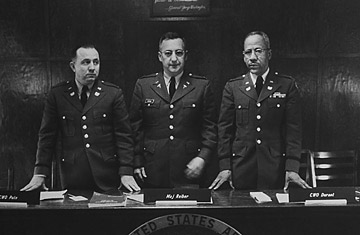
A portrait of the court-martial panel of the U.S. Army taken Oct. 1, 1958
The case of accused Fort Hood gunman Major Nidal Malik Hasan promises to be one of the most prominent military trials in a generation. Prosecutors have filed 13 charges of premeditated murder against Hasan, 39, for the Nov. 5 shooting spree, which wounded 29 others and took place before dozens of witnesses. As an active member of the military, Hasan will be tried by court-martial — no trial date has been set — and if convicted could become the first U.S. serviceman to be executed in nearly 50 years.
The court-martial — essentially a military trial — is the oldest system of justice in the United States, predating even the Constitution and Declaration of Independence. The roots of military law stretch back to ancient Rome, where it was adopted to enforce discipline within the ranks, especially among mercenaries. In 1775, the Continental Congress met at the outbreak of the Revolutionary War and adopted the Articles of War based on Britain's military code. The system was not heavily used in World War I, but in World War II some 2 million people were court-martialed for varying offenses, resulting in 80,000 felony convictions. Among the best known was that of Private Eddie Slovik, a Michigan native who abandoned his unit while in France. Following a military trial in 1944, Slovik was shot dead at 24 years old by a firing squad, the only U.S. service member to be executed for desertion since the Civil War.
Military law has traditionally been stricter and more sweeping than civilian law — the Bill of Rights did not automatically apply to soldiers — but since World War II, military trials have come to more closely resemble civilian trials. Different branches of the armed forces used varying military codes until 1950, when Congress enacted the Uniform Code of Military Justice, now the basis of the military-justice system. Under the code, defendants share many of the same rights as civilians, including the right against self-incrimination and guaranteed access to counsel. But important differences still remain: jury members are chosen by the officer convening the court-martial, and many military convictions cannot be appealed to the Supreme Court, as is the case for civilian defendants. However, capital convictions can be appealed to the high court, and military executions require the specific authorization of the President.
One of the earliest courts-martial in U.S. history occurred in 1779, when Major General Benedict Arnold was tried for using troops for personal gain (he was acquitted of most charges, though convicted of two minor violations). A delay in starting the trial so irritated Arnold that it may have contributed to his betrayal of the nation shortly afterward. A famed 1925 military trial involved Billy Mitchell, an officer in the Army Air Corps who was tried for openly criticizing his superiors for failing to develop airpower fast enough. He was convicted and suspended from active duty with no pay for five years, prompting Mitchell to resign from the Army. The most notorious trial in modern times was that of former Lieutenant William Calley, who was found guilty of participating in the 1968 My Lai massacre in Vietnam. Calley was convicted in 1971 of killing 22 people during the massacre, which cost hundreds of lives. He was sentenced to life in prison but President Nixon ordered his sentence reduced; he was eventually released after three years' house arrest (Calley broke his silence on the massacre last August, saying he was "very sorry" for his actions). The last military execution took place in April 1961, when Army Private John Bennett was hanged for rape and attempted murder. There are currently five men on the military's death row at Fort Leavenworth, Kans.
Former Supreme Court Justice Warren Burger called the American court-martial system "the most enlightened military code in history" — but few would call it perfect. In an unusual public ceremony in Seattle last year, the Army apologized for the wrongful convictions of 28 African-American soldiers of the 43 tried in the largest and longest court-martial of World War II. Most of the men were convicted of rioting amid a 1944 melee at Fort Lawton in which an Italian prisoner of war was lynched; two were convicted of manslaughter. A 2005 book detailing misconduct by prosecutors prompted an Army investigation into the trial, and the convictions were tossed out in 2007. Addressing relatives of the men — only two defendants were still alive, and neither attended the ceremony — then Assistant Army Secretary Ronald James said, "I'm sorry that your father, grandfather and loved ones lost years of their freedom."
